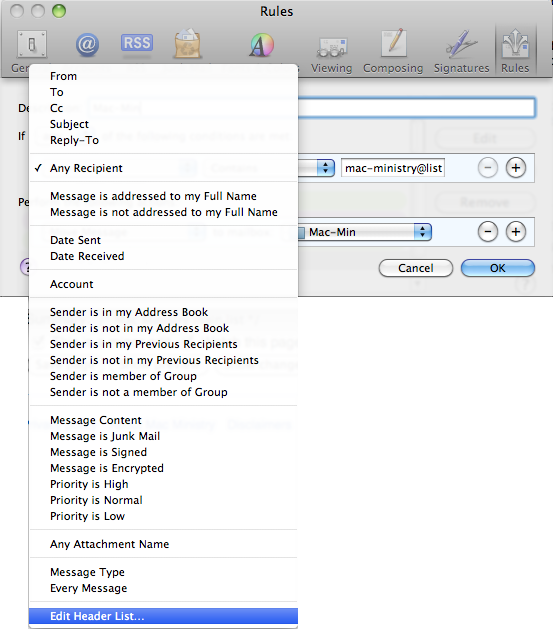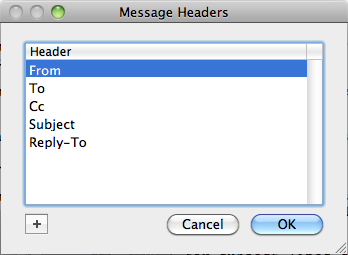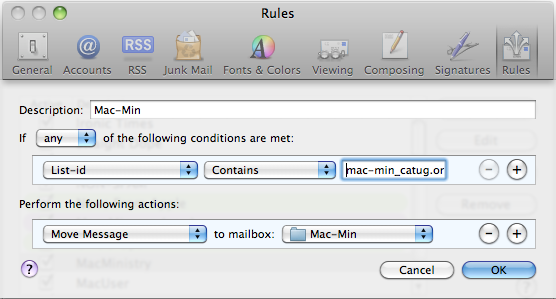Making the most of Apple Mail
This page contain various suggestions to help you make the most of Apple Mail, the default email program on Macintosh computers.
Filtering your emails
It is useful to filter incoming emails from busy mailing lists such as Mac-Min into their own separate folders. This means that your inbox will only contain personal and sundry messages, and that you can catch up on your mailing lists when you have time.
To set up a rule, choose the menu command Mail > Preferences, then click on the Rules icon.
A simple rule for subject lines containing [Mac-Min] works for this list. However, this would mix off-list replies sent to you into the list traffic.
A more specific way to filter Mac-Min messages is to filter by Mailman's list-id header. All messages sent through Mac-Min will have a list-id header that contains mac-min_catug.org.catug.org
In Apple Mail, if List-id is not in the list of fields that you can use in Rules, then select Edit Header List.

This brings up the Message Headers window; click on the + tool at the lower left, and add List-id.

After this, you will be able to use List-id in the same way that you could already filter on From, To, Subject etc.

Default text encoding
Mail automatically handles text encoding for scripts which have special characters not found in English. However, people who regularly exchange messages in such languages, or including other special characters, it may be helpful to change the default text encoding to Unicode (UTF-8).
On the command line in Terminal, type:
- defaults write com.apple.mail NSPreferredMailCharset "UTF-8"
It seems that Mail will always default to the simplest encoding it can, so when you're setting the "default" encoding, all you're overriding is what choice it makes when it has to deviate from its preferred encoding. For a message in plain English, Mail will use US-ASCII which is a simple encoding; but if special characters are present, Mail will use UTF-8 if the above preference has been set.
To check the encoding of a message, use the menu command View > Message > Raw Source, then find the key word "charset".
Sending HTML emails
- The easy part
Assuming that you already know the difficult bit i.e. how to create an HTML file, and just want to send it as an HTML-formatted email rather than an attachment, this is easy on a Mac. Open the html document in Safari, then use the menu command File > Mail Contents of This Page, and Mail will create an html formatted email.
If you need to send it with an email program other than Mail for some reason, just use Mail to email it to yourself and pick it up with the other email application, then re-send it using that app.
- The hard part
Doing HTML emails isn't an easy thing to do. If this is for a non-profit 501(c)3 organization in the US, Christi recommends a free account with Vertical Response. It takes the headache out of HTML emails, and keeps track of your newsletter email list.
If you still want to forge forward in designing HTML emails yourself, this tutorial article might help, but it isn't for the faint in heart.
- An alternative
These days, most people's computers have software for reading PDF files, and Macs can print to PDF. Consider whether sending your message as a PDF file would be adequate for your needs.
Credits
Contributed by various members of CATUG, up to February 2011. Thanks to David Burke and Eric for investigating text encodings, and Christi for her advice on learning HTML.